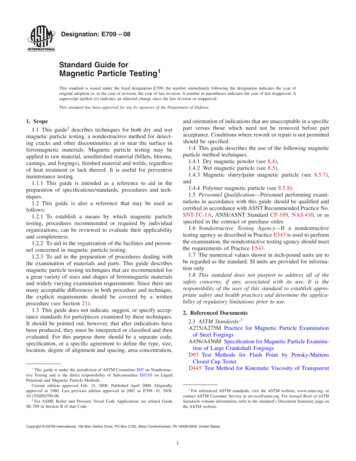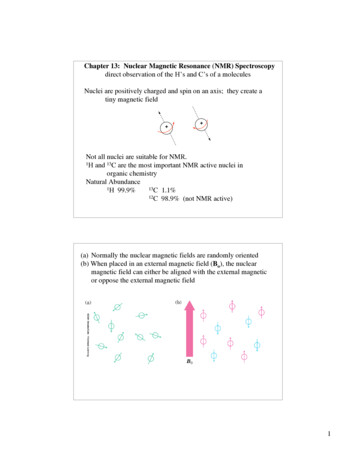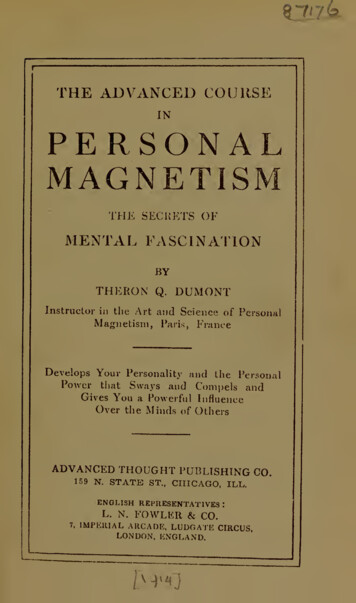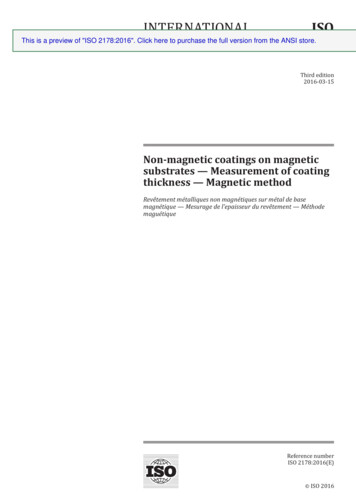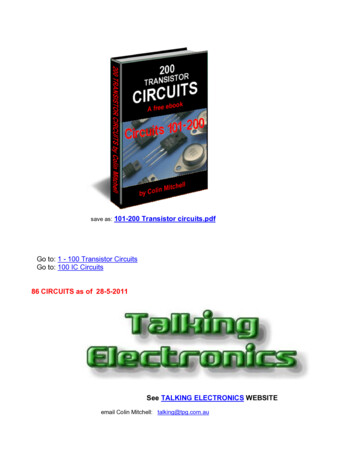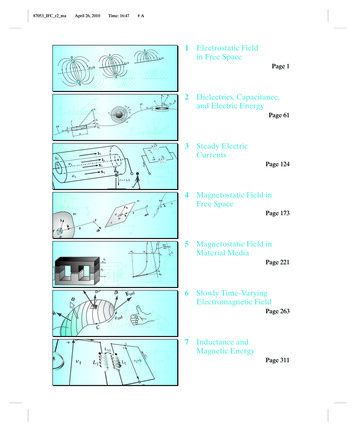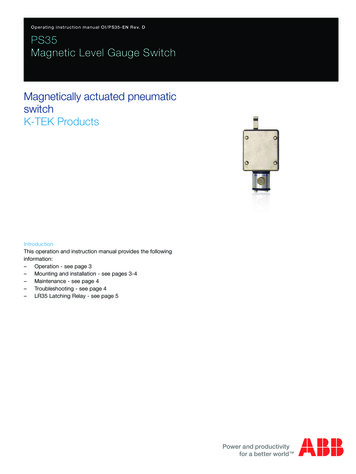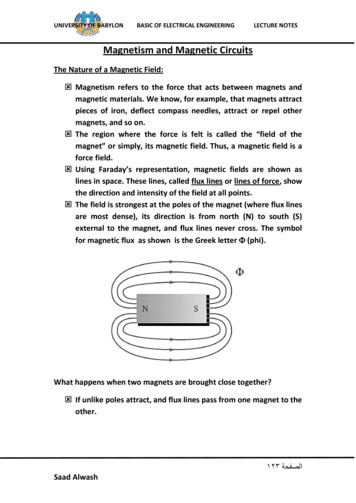
Transcription
UNIVERSITY OF BABYLONBASIC OF ELECTRICAL ENGINEERINGLECTURE NOTESMagnetism and Magnetic CircuitsThe Nature of a Magnetic Field: Magnetism refers to the force that acts between magnets andmagnetic materials. We know, for example, that magnets attractpieces of iron, deflect compass needles, attract or repel othermagnets, and so on. The region where the force is felt is called the “field of themagnet” or simply, its magnetic field. Thus, a magnetic field is aforce field. Using Faraday’s representation, magnetic fields are shown aslines in space. These lines, called flux lines or lines of force, showthe direction and intensity of the field at all points. The field is strongest at the poles of the magnet (where flux linesare most dense), its direction is from north (N) to south (S)external to the magnet, and flux lines never cross. The symbolfor magnetic flux as shown is the Greek letter (phi).What happens when two magnets are brought close together? If unlike poles attract, and flux lines pass from one magnet to theother.321 الصفحة Saad Alwash
UNIVERSITY OF BABYLONBASIC OF ELECTRICAL ENGINEERINGLECTURE NOTES If like poles repel, and the flux lines are pushed backas indicated by the flattening of the field betweenthe two magnets. Ferromagnetic Materials (magnetic materials that are attractedby magnets such as iron, nickel, cobalt, and their alloys) arecalled ferromagnetic materials. Ferromagnetic materials providean easy path for magnetic flux. The flux lines take the longer (but easier) path through the softiron, rather than the shorter path that they would normally take.Note, however, that nonmagnetic materials (plastic, wood, glass,and so on) have no effect on the field.321 الصفحة Saad Alwash
UNIVERSITY OF BABYLONBASIC OF ELECTRICAL ENGINEERINGLECTURE NOTESElectromagnetism:Most applications of magnetism involve magnetic effects due toelectric currents. The current, I, creates a magnetic field that isconcentric about the conductor, uniform along its length, and whosestrength is directly proportional to I. Note the direction of the field.It may be remembered with the aid of the right-hand rule, imagineplacing your right hand around the conductor with your thumbpointing in the direction of current. Your fingers then point in thedirection of the field. If you reverse the direction of the current, thedirection of the field reverses.321 الصفحة Saad Alwash
UNIVERSITY OF BABYLONBASIC OF ELECTRICAL ENGINEERINGLECTURE NOTESIf the conductor is wound into a coil(Provided no ferromagneticmaterial is present) , the fields of its individual turns combine,producing a resultant field as in Figure. The direction of the coil flux canalso be remembered by means of a simple rule: curl the fingers of yourright hand around the coil in the direction of the current and yourthumb will point in the direction of the field. If the direction of thecurrent is reversed, the field also reverses. Provided no ferromagneticmaterial is present, the strength of the coil’s field is directlyproportional to its current.If the coil is wound on a ferromagnetic core as in Figure below(transformers are built this way), almost all flux is confined to the core,although a small amount (called stray or leakage flux) passes throughthe surrounding air. However, now that ferromagnetic material ispresent, the core flux is no longer proportional to current.321 الصفحة Saad Alwash
UNIVERSITY OF BABYLONBASIC OF ELECTRICAL ENGINEERINGLECTURE NOTESFlux and Flux Density:The magnetic flux is represented by the symbol . In the SIsystem, the unit of flux is the weber (Wb). However, we are often moreinterested in flux density B (i.e., flux per unit area) than in total flux .Since flux is measured in Wb and area A in m2, flux density ismeasured as Wb/m2, the unit of flux density is called the tesla (T)where 1 T 1 Wb/m2. Flux density is found by dividing the total fluxpassing perpendicularly through an area by the size of the area is,EXAMPLE : For the magnetic core of Figure below, the flux density atcross section 1 is B1 0.4 T. Determine B2.Sol/Since all flux is confined to the core,the flux at cross section 2 is thesame as at cross section 1. *******************321 الصفحة Saad Alwash
UNIVERSITY OF BABYLONBASIC OF ELECTRICAL ENGINEERINGLECTURE NOTESPERMEABILITY:If cores of different materials with the same physical dimensionsare used in the electromagnet, the strength of the magnet will vary inaccordance with the core used. This variation in strength is due to thegreater or lesser number of flux lines passing through the core.Materials in which flux lines can readily be set up are said to bemagnetic and to have high permeability. The permeability (µ) of amaterial It is similar in many respects to conductivity in electric circuits.The permeability of free space(vacuum) is.The permeability of all nonmagnetic materials, such as copper,aluminum, wood, glass, and air, is the same as that for free space.Materials that have permeabilities slightly less than that of free spaceare said to be diamagnetic, and those with permeabilities slightlygreater than that of free space are said to be paramagnetic. Materialswith these very high permeabilities are referred to as ferromagnetic.The ratio of the permeability of a material to that of free space iscalled its relative permeability; that is,In general, for ferromagnetic materials,nonmagnetic materials,., and forRELUCTANCE:The resistance of a material to the flow of charge (current) isdetermined for electric circuits by the equation,The reluctance of a material to the setting up of magnetic flux lines inthe material is determined by the following equation:321 الصفحة Saad Alwash
UNIVERSITY OF BABYLONBASIC OF ELECTRICAL ENGINEERINGLECTURE NOTESwhere is the reluctance, is the length of the magnetic path, and Ais the cross-sectional area. The units At/Wb is the number of turns ofthe applied winding. More is said about ampere-turns (At)MMF: The Source of Magnetic Flux:Current through a coil creates magnetic flux. The greater thecurrent or the greater the number of turns, the greater will be the flux.This flux-producing ability of a coil is called its magnetomotive force(mmf). Magnetomotive force is given the symbol and is defined asOhm’s Law for Magnetic Circuits:The relationship between flux, mmf, and reluctance isEXAMPLE : For Figure shown below, if the reluctance of the magneticcircuit is, what is the flux in the circuit?Sol/321 الصفحة Saad Alwash
UNIVERSITY OF BABYLONBASIC OF ELECTRICAL ENGINEERINGLECTURE **************Magnetic Field Intensity and Magnetization Curves :We now look at a more practical approach to analyzing magneticcircuits. First, we require a quantity called magnetic field intensity, H(also known as magnetizing force). It is a measure of the mmf per unitlength of a circuit. We can define magnetic field intensity as the ratioof applied mmf to the length of path that it acts over. Thus,( )Rearranging Equation yields an important result:()In an analogy with electric circuits , the NI product is an mmf source,while theproduct is an mmf drop.The Relationship between B and H:The flux density and the magnetizing force are related by the followingequation:311 الصفحة Saad Alwash
UNIVERSITY OF BABYLONBASIC OF ELECTRICAL ENGINEERINGLECTURE NOTESwhere is the permeability of the core, therefore, the larger the valueof , the larger the flux density for a given magnetizing current.For all practical purposes, the permeability of air and othernonmagnetic materials is the same as for a vacuum. Thus, in air gaps,B-H Curves:For ferromagnetic materials, is not constant but varies withflux density and there is no easy way to compute it. In reality,however, it isn’t m that you are interested in: What you really want toknow is, given B, what is H, and vice versa. A set of curves, called B-Hor magnetization curves, provides this information. (These curves areobtained experimentally and are available in handbooks. A separatecurve is required for each material.) Figure shows typical curves forcast iron, cast steel, and sheet steel.B-H curve (magnetization curves)313 الصفحة Saad Alwash
UNIVERSITY OF BABYLONBASIC OF ELECTRICAL ENGINEERINGLECTURE NOTESEXAMPLE : If B 1.4 T for sheet steel, what is H?Sol/For sheet steel, H 1000 At/m, when B 1.4 T.Air Gaps, Fringing, and Laminated Cores:The spreading of the flux lines outside the common area of thecore for the air gap in Figure(a) is known as fringing. For our purposes,we shall neglect this effect and assume the flux distribution to be as inFigure (b) .For magnetic circuits with air gaps, fringing occurs, causing adecrease in flux density in the gap. For short gaps, fringing can usuallybe neglected. Alternatively, correction can be made by increasing eachcross-sectional dimension of the gap by the size of the gap toapproximate the decrease in flux density.312 الصفحة Saad Alwash
UNIVERSITY OF BABYLONBASIC OF ELECTRICAL ENGINEERINGLECTURE NOTESAmpere’s Circuital Law:If we apply the analogy to Kirchhoff’s voltage law (for magneticcircuits). States that the algebraic sum of the rises and drops of the mmfaround a closed loop of a magnetic circuit is equal to zero; that is, thesum of the rises in mmf equals the sum of the drops in mmf around aclosed loop. Equation is referred to as Ampère’s circuital law. When itis applied to magnetic circuits, sources of mmf are expressed by theequation. The summation is algebraic and terms are additive orsubtractive, depending on the direction of flux and how the coils arewound. Consider the magnetic circuit appearing in Figure constructed ofthree different ferromagnetic materials. Applying Ampère’s circuitallaw, we have311 الصفحة Saad Alwash
UNIVERSITY OF BABYLONBASIC OF ELECTRICAL ENGINEERINGLECTURE NOTESWhich states that the applied mmf NI is equal to the sum of thedropsaround the loop. The path to use for theterms is themean (average) path.You now have two magnetic circuit models (Figure below).While the reluctance model (a) is not very useful for solving problems,it helps relate magnetic circuit problems to familiar electrical circuitconcepts. The Ampere’s law model, on the other hand, permits us tosolve practical problems.Series Elements and Parallel Elements:Magnetic circuits may have sections of different materials. Forexample, the circuit of Figure has sections of cast iron, sheet steel, andan air gap. For this circuit, flux is the same in all sections. Such a circuitis called a series magnetic circuit. Although the flux is the same in allsections, the flux density in each section may vary, depending on itseffective cross-sectional area as you saw earlier.311 الصفحة Saad Alwash
UNIVERSITY OF BABYLONBASIC OF ELECTRICAL ENGINEERINGLECTURE NOTESA circuit may also have elements in parallel (Figure). At each junction,the sum of fluxes entering is equal to the sum leaving. This is thecounterpart of Kirchhoff’s current law. ThusSeries Magnetic Circuits: Given , Find NIYou now have the tools needed to solve basic magnetic circuitproblems. This type can be solved using four basic steps:1) Compute B for each section using.2) Determine H for each magnetic section from the B-H curves.Usefor air gaps.3) Compute NI using Ampere’s circuital law.4) Use the computed NI to determine coil current or turns asrequiredPRACTICAL NOTES.Magnetic circuit analysis is not as precise as electric circuit analysisbecause The assumption of uniform flux density breaks down at sharpcorners. The B-H curve is a mean curve and has considerable uncertainty.Although the answers are approximate, they are adequate for mostpurposes.311 الصفحة Saad Alwash
UNIVERSITY OF BABYLONBASIC OF ELECTRICAL ENGINEERINGLECTURE NOTESEXAMPLE : For the series magnetic circuit of Figurea) Find the value of I required to develop a magnetic flux ofb) DetermineandSol/for the material under these conditions.,,The flux density B isUsing the B-H curves, we can determine the magnetizing force H:Applying Ampère’s circuital law yields:,b. The permeability of the material can be *********************311 الصفحة Saad Alwash
UNIVERSITY OF BABYLONBASIC OF ELECTRICAL ENGINEERINGLECTURE NOTESExample: The laminated sheet steel section of Figure hasa stacking factor of 0.9. Compute the current required toestablish a flux of. Neglect fringing.Sol/ Convert all dimensions to metric.Cast iron:From B-H curve (Cast iron)Sheet steel:311 الصفحة Saad Alwash
UNIVERSITY OF BABYLONBASIC OF ELECTRICAL ENGINEERINGLECTURE NOTESFrom B-H curve (Sheet steel)Air gap:()Ampere's ******************Example: Figure shows below a portion of a solenoid. Fluxwhen I 2.5 amps. Find the number of turns on thecoil.( Solenoid. All parts are cast steel)311 الصفحة Saad Alwash
UNIVERSITY OF BABYLONBASIC OF ELECTRICAL ENGINEERINGLECTURE NOTESSol\yoke:From B-H curve (cast steel )Plunger:From B-H curve (cast steel)Air gap:()Ampere's *****************311 الصفحة Saad Alwash
UNIVERSITY OF BABYLONBASIC OF ELECTRICAL ENGINEERINGLECTURE NOTESEXAMPLE: Determine the secondary current I2 for thetransformer of Figure shown, if the resultant clockwise flux inthe core is.Sol/ you will note that the resulting flux of each is opposing, justas the two sources of voltage are opposing in the electric circuitanalogy.,I1 2A,N2 30 turns, N1 60 turnsFrom B-H curve (sheet steel)Applying Ampère’s circuital ********Series-Parallel Magnetic Circuits:Series-parallel magnetic circuits are handled using the sum offluxes principle and Ampere’s law.311 الصفحة Saad Alwash
UNIVERSITY OF BABYLONBASIC OF ELECTRICAL ENGINEERINGLECTURE NOTESExample : The core of Figure below is cast steel. Determine thecurrent to establish an air-gap flux. Neglectfringing.Cast steelSol/ Air Gap()Sections ab and cdFrom B-H curveAmpere’s Law (Loop 2), From B-H curve313 الصفحة Saad Alwash
UNIVERSITY OF BABYLONBASIC OF ELECTRICAL ENGINEERINGLECTURE NOTESFrom B-H curveAmpere’s Law (Loop *********Series Magnetic Circuits: Given NI, Find :For the special case of a core of one material andconstant cross sectionExample: For the circuit of Figure , NI 250 At. Determine sol/From B-H curve(cast steel)B 1.2T , ************************For circuits with two or more sections, the process is not so simple.312 الصفحة Saad Alwash
example, the circuit of Figure has sections of cast iron, sheet steel, and an air gap. For this circuit, flux is the same in all sections. Such a circuit is called a series magnetic circuit. Although the flux is the same in all sections, the flux density in each section may vary, depending on its effective cross-sectional area as you saw earlier.
